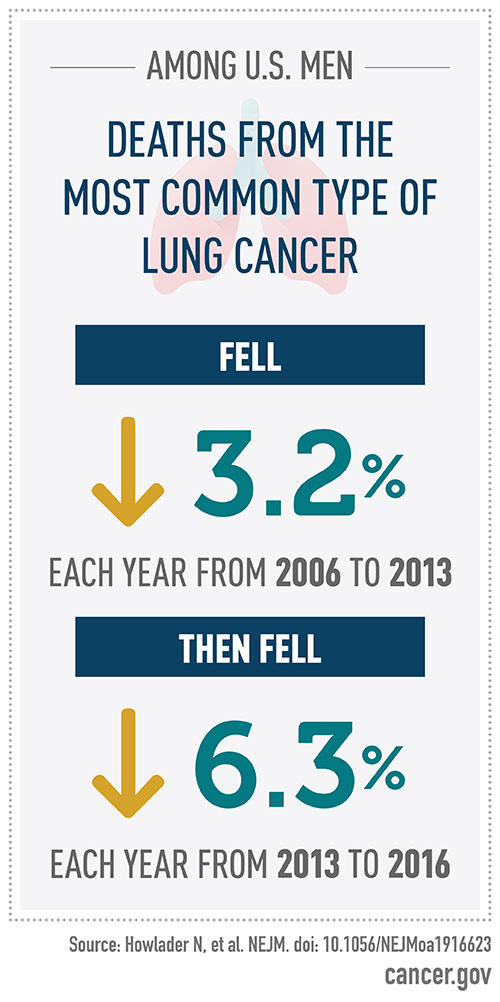
New treatments spur sharp reduction in lung cancer mortality rate
- Posted:
Contact:
NCI Press Office
240-760-6600
According to a new study, mortality rates from the most common lung cancer, non-small cell lung cancer (NSCLC), have fallen sharply in the United States in recent years, due primarily to recent advances in treatment.
The study was led by researchers at the National Cancer Institute (NCI), part of the National Institutes of Health. The findings were published August 12, 2020, in the New England Journal of Medicine.
“Reduced tobacco consumption in the U.S. has been associated with a progressive decrease in lung cancer deaths that started around 1990 in men and around 2000 in women. Until now, however, we have not known whether newer treatments might contribute to some of the recent improvement,” said Douglas R. Lowy, M.D., NCI deputy director and co-author of this study. “This analysis shows for the first time that nationwide mortality rates for the most common category of lung cancer, non-small cell lung cancer, are declining faster than its incidence, an advance that correlates with the [U.S. Food and Drug Administration] approval of several targeted therapies for this cancer in recent years.”
In this study, researchers looked at data for both NSCLC, which accounts for 76% of lung cancer in the U.S., and small-cell lung cancer (SCLC), which accounts for 13% (other subtypes of lung cancer that constitute the remaining share of cases were not covered in this study). In the last decade, new treatments for NSCLC have become available, including those that target genetic changes seen in some NSCLC tumors as well as immune checkpoint inhibitors that help the immune system better attack NSCLC. In contrast, there have been limited treatment advancements for SCLC.
Although death records do not distinguish between lung cancer deaths attributable to NSCLC versus SCLC, the cancer diagnosis records compiled by NCI’s Surveillance, Epidemiology, and End Results (SEER) cancer registry program do distinguish between these two subtypes of lung cancer. Therefore, the researchers were able to estimate lung cancer mortality trends for these specific lung cancer subtypes by linking the lung cancer death records for each patient back to the incidence data for these patients in the SEER cancer database.
The researchers found that, in recent years, deaths from NSCLC decreased even faster than the decrease in NSCLC incidence and the decrease in deaths was associated with a substantial improvement in survival. Among men, for example, deaths from NSCLC decreased 3.2% annually from 2006 to 2013 and 6.3% annually from 2013 to 2016, whereas incidence decreased 1.9% annually during 2001 to 2008 and 3.1% annually from 2008 to 2016.
Two-year survival for men with NSCLC improved over this time, from 26% for patients diagnosed in 2001 to 35% for those diagnosed in 2014. Similar improvement was observed for women. In addition, improvements in two-year survival were seen for all races/ethnicities, despite concerns that the newer cancer treatments, many of which are expensive, might increase disparities.
The researchers had originally considered the possibility that lung cancer screening might help explain the decreases in NSCLC mortality, but their findings suggest that lung cancer screening rates, which remained low and stable, do not explain the mortality declines. Instead, the rapid decline in deaths reflects both declines in incidence (due in large part to reductions in smoking) and improvement in treatment.
In contrast, the decrease in deaths from SCLC corresponded with the decrease in incidence, and two-year survival was largely unchanged. Among men, for example, deaths declined 4.3% annually and incidence 3.6% annually. Findings were similar among women. The reduced mortality from SCLC over time, therefore, primarily reflects declines in incidence—again, due largely to reduced smoking.
The researchers note that the accelerating decline in NSCLC mortality that began in 2013 corresponds with the time when clinicians began routinely testing patients for genetic alterations targeted by newly approved drugs. In 2012, the National Comprehensive Cancer Network recommended that all patients with nonsquamous NSCLC undergo genetic testing. Subsequently, genetic testing for EGFR (epidermal growth factor receptor) mutations and ALK (anaplastic lymphoma kinase) gene rearrangements—which are targeted by the newer treatments—increased substantially. Because immune checkpoint inhibitors were not in widespread use over the period of the analysis, the authors suspect that most of the survival benefit was attributable to effective EGFR or ALK inhibitors or other advances in therapy. The effect of immune checkpoint inhibitors on NSCLC survival is significant, which suggests that this improving trend in survival should continue beyond 2016.
“The survival benefit for patients with non-small cell lung cancer treated with targeted therapies has been demonstrated in clinical trials, but this study highlights the impact of these treatments at the population level,” said Nadia Howlader, Ph.D., of NCI’s Division of Cancer Control and Population Sciences, who led the study. “We can now see the impact of advances in lung cancer treatment on survival.”
About the National Cancer Institute (NCI): NCI leads the National Cancer Program and NIH’s efforts to dramatically reduce the prevalence of cancer and improve the lives of cancer patients and their families, through research into prevention and cancer biology, the development of new interventions, and the training and mentoring of new researchers. For more information about cancer, please visit the NCI website at cancer.gov or call NCI’s contact center, the Cancer Information Service, at 1-800-4-CANCER (1-800-422-6237).
About the National Institutes of Health (NIH): NIH, the nation's medical research agency, includes 27 Institutes and Centers and is a component of the U.S. Department of Health and Human Services. NIH is the primary federal agency conducting and supporting basic, clinical, and translational medical research, and is investigating the causes, treatments, and cures for both common and rare diseases. For more information about NIH and its programs, visit nih.gov.























.png)









No hay comentarios:
Publicar un comentario